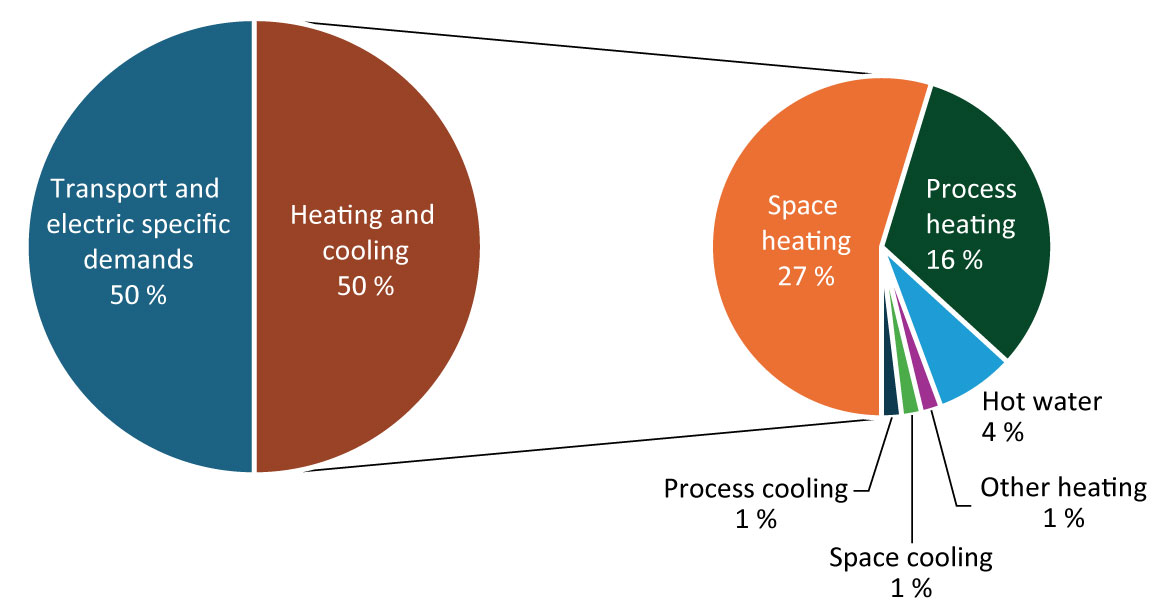Most of this energy is dedicated to space heating in buildings, which constitutes 27% of Europe’s energy demand[1]. Additionally, industrial processes account for 16% of the continent’s final energy demand. While electricity production is transitioning to cleaner sources, heat production still heavily relies on fossil fuels, with natural gas being the dominant heating source in Europe. There is thus an urgent demand for decarbonization of the heating sector.

The total final energy consumption in EU28, and the distribution of
energy consumption related to heating and cooling (H/C) (reproduced from1).
At the same time, the increasing share of fluctuating renewable energy sources—such as wind and solar—requires a more flexible energy system. In 2023, wind produced more electricity than gas in the EU for the first time[1], and about a quarter of all hours in 2023 had less than 25% of electricity from fossil fuels. Consequently, Europe experienced an explosion of negative electricity prices in 2023[2], which calls for flexible technologies that can adjust electricity consumption to align with abundant renewable power availability.
By decarbonising heat supply through heat pumps and electric boilers, we create a link between the heating and the power sector. Integrating these technologies with thermal energy storage at different scales unlocks a huge flexibility potential.
These two challenges can be partially met by the same solution. By decarbonizing heat supply through power-to-heat technologies, e.g., heat pumps and electric boilers, we create a link between the heating sector to the power sector. Additionally, integrating the power-to-heat units with thermal energy storage at different scales unlocks a huge flexibility potential. When end-use is heating, thermal energy storage is a far more cost-efficient and environmentally friendly compared to battery-based energy storage.
Potential for flexibility
The core of the FLXenabler project lies in looking at the connection between the power and heating sectors while showcasing the underlying potential for flexibility. The hypothesis is that by coupling power and heating sectors, along with integrating thermal energy storage, the transition to a fossil-free energy system will accelerate and become more affordable. To prove this, the project will use energy system optimization models to quantify the impact of flexible heating and cooling solutions at different levels in the energy system. The project team consists of researchers from SINTEF and Equinor, TU Wien in Austria, as well as NREL and US Geological Survey from the US.
The flexibility potential for large-scale heat pumps and thermal energy storage units coupled to district heating systems is particularly large. As part of the project’s initial tasks, we have quantified the portion of Europe’s heating demand that can be satisfied through district heating. This information has been incorporated into the large-scale energy system model GENeSYS-MOD. In addition to the space heating sector, industrial process heating at different temperature levels is also included in the model. The project aims to provide a comprehensive assessment of how coupling the power and heating sectors impacts investments in the transition to a fully decarbonized energy system, in both Europe and the US.
Open-source tools
The project will leverage open-source tools for energy system modelling at different geographical scales, from energy communities to European level. The project will employ algorithms that can adjust the scale of analysis, including upscaling and downscaling. Upscaling includes considering findings from smaller energy systems (such as local communities) within larger contexts (such as national or continental scales). The Austrian team is working with how flexible thermal energy sources in low-carbon energy communities can capture value in flexibility markets in a larger context. Downscaling includes refining insights from broader models to understand specific local impacts. For example, the Austrian team has worked with how district heating expansion plans from a European context can be implemented in the city of Oslo[1].
The US team works to understand the potential of geothermal district energy systems in contributing to the decarbonization of the energy supply in the US. They have identified cities and districts within the US that has the highest value and potential for geothermal district energy systems. The project will also develop and utilize simulation tools specifically designed for underground thermal energy storage. These tools allow us to explore the feasibility, efficiency, and effectiveness of storing excess heat or cold in subsurface reservoirs.
In summary, the FLXenabler project aims to quantify the impacts of sector coupling, leverage open-source modeling tools, and explore innovative solutions like underground thermal energy storage. By quantifying these impacts, the project will reveal the benefits of integrating flexible heating and cooling solutions. These benefits include cost reduction and acceleration of the transition toward cleaner energy sources.
[1] Heat Roadmap Europe (2017) .Heating and Cooling facts and figures.
[2] European Electricity Review 2024 | Ember (ember-climate.org)
[3] ACER: Explosion of negative electricity prices in EU in 2023 (balkangreenenergynews.com)
[4] Is the decarbonization of the European energy system driving district heating in Norway? | IEEE Conference Publication | IEEE Xplore









Comments
No comments yet. Be the first to comment!